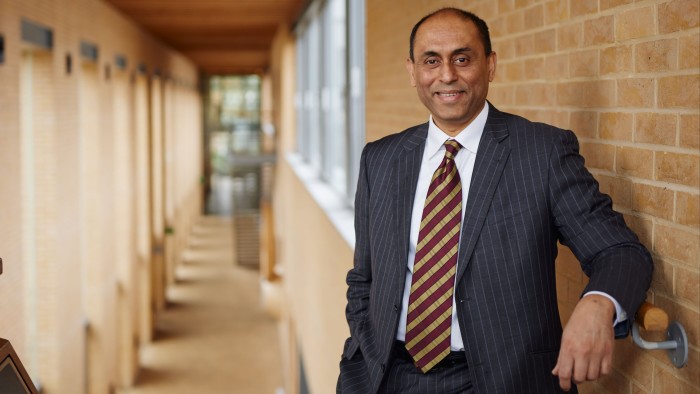If you want to gauge the influence of academic research, look at who is paying for it. External funding is the lifeblood of fields such as science and engineering, with large government grants and philanthropic or industry money propelling research forward.
And, because this financial backing often comes with strings attached, it ensures accountability and real-world outcomes beyond publication in academic journals.
But business schools are not in the same situation when trying to make their research applicable to business leaders, policymakers and others who can use it in practice. They receive far less external funding compared with other disciplines.
In 2022, US universities spent $97.8bn on research and development, most of it coming from the government and, to a lesser extent, private institutions. About $76.2bn, or 78 per cent, was allocated to science. Business received $1.08bn, a mere 1.1 per cent of total funding. This gap could have real consequences for the push to make business school research more relevant and applicable to the real world.
“Most philanthropic foundations must report regularly to their boards on how closely results align with their mission, making them deeply focused on long-term impact,” explains Julia Lane, a professor at the NYU Wagner Graduate School of Public Service.
“Public funding typically focuses on intellectual merit — contributing to scientific knowledge through patents and publications — and on serving the public good, like training the next generation of scholars.”
Some business schools say they rely more on tuition fees and alumni donations to support their research, which may not always come with the same level of oversight that external grants bring to science and engineering.
Soumitra Dutta, dean of Saïd Business School at the University of Oxford, acknowledges this. “Business schools do, probably, have more tuition and donor research funding compared to other fields,” he says.
James Wilsdon, professor of research policy at University College London, explains that stagnating public funding in the UK has increased their reliance on tuition fees for research. The Higher Education Policy Institute estimates that the “T to R” cross-subsidy in UK higher education, where tuition fees are used to fund research, is worth up to £1.27bn a year.
This figure is for all disciplines, but Wilsdon adds: “It has been a long-running lament of business and management as a discipline that it gets relatively little research funding.”
Moritz Scherleitner, assistant professor of accounting at Finland’s Aalto University School of Business, is familiar with those challenges. He tells his PhD candidates that frequent rejection of external funding proposals is part of the job. “If you cannot handle that, academia may not be for you,” he says, noting success rates can be as low as one in 10.
Scherleitner believes that competition for external funds raises the quality of research questions and sharpens its focus on impact. “Research funding is high-risk, high-reward,” he says. “You have to be prepared to spend months on an application that may be rejected, but it pushes you to aim for better societal impact.”
Some big funders argue that wealthy business schools, particularly in the US where endowments are worth billions of dollars, no longer need extra financial support. The Sloan Foundation in New York, for example, has shifted its focus away from business schools, which now receive 2.7 per cent of its $50mn annual research budget.
Most of the foundation’s funding today goes to research in the Stem subjects and economics, which often sits outside business schools. “We pick areas where research can inform policy,” says Adam Falk, president of the foundation.
However, some funders still see value in financing business school research. John Liew, co-founder of AQR Capital Management, says he built his career and hedge fund on the research he encountered during his PhD at the University of Chicago Booth School of Business in the 1990s. Those ideas include “factor investing”, an approach AQR takes where market returns are dissected and systematically exploited.
Liew and AQR co-founder Cliff Asness, also a Booth alumnus, recently made a $60mn donation to their alma mater, adding to past gifts. Some of the funds have been used to recruit junior finance faculty and support their research.
“We are big consumers of academic research,” says Liew. He adds, however, that he does not track the impact of the research he supports, nor does he influence its direction, respecting academic freedom.
Dutta, at Oxford Saïd, defends the reliance on these alumni donations, arguing that it helps keep the research relevant to business needs. “Our research can seek to answer issues that are important to industry — this is a positive thing,” he argues.
That said, Dutta stresses the importance of maintaining a balanced funding mix. To increase accountability, he focuses on incentivising faculty to pursue external grants and not just to publish in academic journals. He is also hiring research office staff to support proposal writing and boost the odds of securing funds.
Some business schools are teaming up with other university departments to attract more outside funding and increase research impact. “It is true that, traditionally, external research funding skews towards the hard sciences,” says Francesca Cornelli, dean of Kellogg School of Management at Northwestern University.
“One avenue we have pursued is partnering with other schools across the university on research initiatives . . . that present opportunities for a broader set of supporters to engage,” she explains, pointing to a recent $20mn National Science Foundation grant for a joint research project with Northwestern’s engineering faculty.
Ultimately, Lane at NYU Wagner says that, to raise accountability, schools should prioritise research projects that have the potential to generate external funding. “Universities are businesses,” she says. “You have got to follow the money.”
Read the full article here

